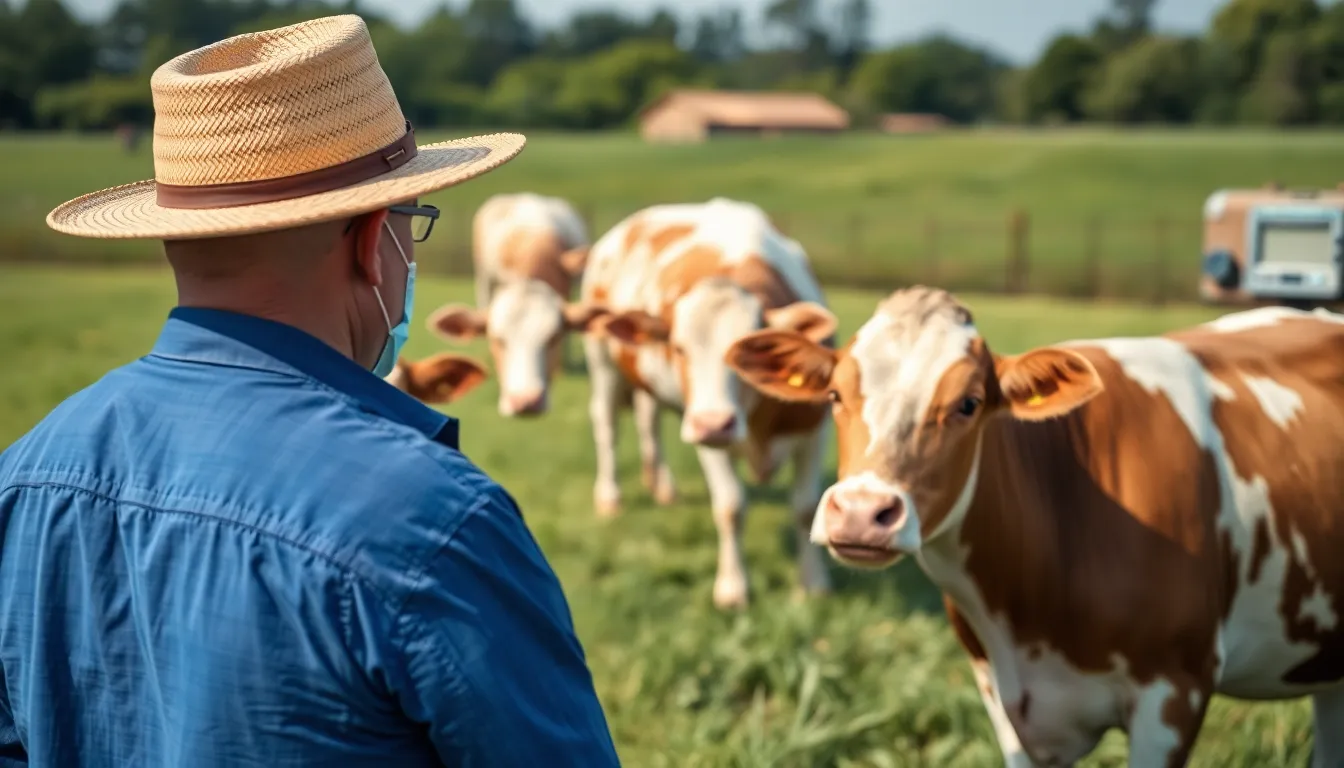Imagine a world where cows are not just mooing machines but tech-savvy partners in dairy farming. Welcome to the age of IoT dairy farming, where farmers harness the power of the Internet of Things to transform their operations. With smart sensors and data analytics, they can monitor every udder and pasture, ensuring happy cows and a bountiful milk supply.
Table of Contents
ToggleOverview of IoT Dairy Farming
IoT dairy farming represents a significant shift in agricultural practices. It employs interconnected devices to enhance efficiency in milk production and animal care.
Definition of IoT Dairy Farming
IoT dairy farming encompasses the integration of smart sensors and devices within dairy production systems. These technologies monitor cattle health, track vital data, and automate routine tasks. Each device collects relevant information, such as temperature and heart rate, allowing farmers to respond quickly to their animals’ needs. Data analytics play a vital role, enabling informed decisions that enhance herd management. Overall, IoT integration transforms traditional dairy practices, driving productivity.
Importance in Modern Agriculture
Importance lies in increasing operational efficiency and sustainability. IoT technologies enable precise monitoring of resource usage, leading to reduced waste. Farmers benefit from real-time insights, which enhance disease prevention and improve cow welfare. Milk quality and yield increase as a result of optimized feeding and care protocols. Embracing IoT also contributes to better record-keeping and compliance with regulations. By adopting these innovations, dairy farms can meet consumer demands while reducing their environmental footprint.
Key Technologies in IoT Dairy Farming
IoT dairy farming relies on advanced technologies that transform traditional practices. These technologies include sensors, monitoring devices, and data analytics tools designed specifically for optimal farm management.
Sensors and Monitoring Devices
Smart sensors play a crucial role in monitoring animal health and environmental conditions. Sensors collect data on parameters such as temperature, humidity, and animal behavior. Wearable devices track each cow’s location, activity level, and physiological metrics. By analyzing this data, farmers can identify potential health issues early. Monitoring devices also facilitate real-time insights into pasture conditions, allowing farmers to make informed decisions about feed and grazing management.
Data Analytics and Management Tools
Data analytics tools enable farmers to process large volumes of information collected from sensors. These tools offer insights into trends related to milk production and cow well-being. By utilizing machine learning algorithms, farmers can predict outcomes and optimize resource allocation. Management systems streamline operations by integrating data from various sources, enhancing decision-making. Accurate analytics allow for timely interventions, significantly improving herd health and productivity.
Benefits of IoT in Dairy Farming
IoT technology offers substantial advantages in dairy farming, enhancing efficiency and ensuring better animal care. The integration of smart technology leads to more productive farming practices.
Enhanced Productivity and Efficiency
IoT systems improve productivity by automating routine tasks. Sensors collect data on optimal feeding times and milk production levels, allowing farmers to make informed decisions. Real-time monitoring ensures that resources are allocated effectively to meet the demands of the herd. Automation in milking and feeding operations reduces labor costs and minimizes human error. Additionally, data analytics highlights trends that help farmers adapt strategies to improve overall output. By streamlining operations, IoT technology fosters an environment where both animals and farmers thrive.
Improved Animal Health and Welfare
Animal health improves significantly through IoT applications in dairy farming. Wearable devices track each cow’s vital signs, ensuring early detection of health issues. Consistent monitoring of behavior and physical metrics allows farmers to respond promptly to any changes, enhancing animal well-being. Smart sensors also monitor environmental conditions, helping maintain optimal living conditions in barns. This proactive approach reduces the incidence of diseases and stress among the herd. Ultimately, healthier cows contribute to enhanced milk quality and yield, benefiting both farmers and consumers.
Challenges and Considerations
IoT dairy farming presents unique challenges and considerations that farmers must address to maximize efficiency and productivity.
Infrastructure and Connectivity Issues
Connectivity remains a critical factor in IoT dairy farming. Many rural areas lack the robust internet infrastructure required to support real-time data transmission. This limitation can hinder the effective use of smart sensors and monitoring devices. Additionally, ensuring stable connections for wearable devices poses challenges, as intermittent connectivity can lead to data loss. Proper planning regarding network coverage, including investments in reliable solutions like satellite or cellular networks, helps mitigate these issues. Farmers must evaluate existing infrastructure and explore alternatives to ensure continuous data access and functionality.
Data Security and Privacy Concerns
Data security and privacy stand as significant concerns in IoT dairy farming. The collection of vast amounts of sensitive information raises the risk of cyber threats. Breaches can compromise not only farm operations but also individual privacy. Implementing strong cybersecurity measures, such as encryption and access controls, helps safeguard sensitive data. It’s crucial for farmers to stay informed about best practices and emerging threats to protect their information. Furthermore, compliance with data protection regulations ensures that privacy concerns remain addressed throughout the integration of IoT technology in farming.
Future Trends in IoT Dairy Farming
Innovations in IoT dairy farming aim to enhance efficiency and productivity while improving animal welfare. Several factors contribute to the future landscape of this industry.
Advancements in Technology
Emerging technologies drive significant changes in IoT dairy farming. Artificial intelligence enhances data analytics, allowing farmers to derive actionable insights from vast amounts of data. Drones offer aerial surveillance to monitor pasture conditions and herd movements more effectively. Robotics streamline feeding and milking processes, further reducing labor costs. Wireless communication improves connectivity between devices, facilitating real-time data sharing. These advancements collectively contribute to a more intelligent, responsive farming system that can adapt to dynamic conditions.
Sustainability and Environmental Impact
Sustainability plays a critical role in the future of IoT dairy farming. Smart monitoring systems help manage resources like water and feed, reducing waste and promoting environmentally friendly practices. Nutritional profiling enables precise feeding strategies to minimize methane emissions. Data-driven decisions also support better land management, fostering regenerative practices that enhance soil health. By adopting these sustainable approaches, dairy farmers can lower their environmental impact while meeting growing consumer demands for ethically produced products.
Conclusion
Embracing IoT technology in dairy farming is transforming the industry. By integrating smart sensors and data analytics, farmers can enhance animal welfare while optimizing milk production. This tech-driven approach not only streamlines operations but also provides valuable insights into herd health and environmental conditions.
As advancements continue to emerge, the potential for improved efficiency and sustainability grows. Addressing challenges like connectivity and data security will be crucial for maximizing these benefits. Ultimately, the future of dairy farming looks promising, with IoT playing a vital role in meeting the demands of a rapidly evolving agricultural landscape.







